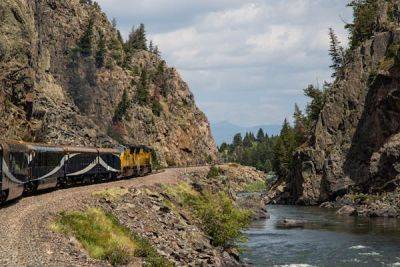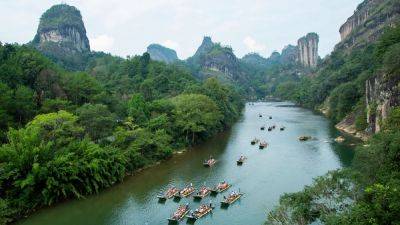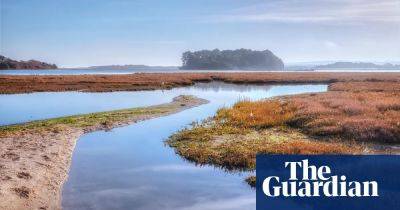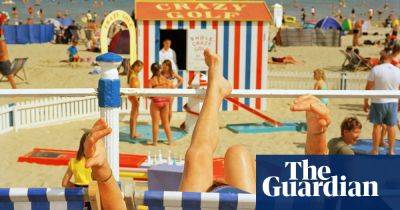Normandy Tourism, with the support of the Normandy Region, is proud to announce the launch of the “Explore Normandy Pass,” dedicated this year to Remembrance Tourism to mark the 80th anniversary of the Normandy Landings. This innovative digital solution offers an enriched exploration of the cultural and historical wealth of Normandy. Michael Dodds, Director of the Normandy Regional Tourist Board, emphasizes the importance of these remembrance sites: “These places of remembrance, which welcome visitors throughout the year, are still the best way to understand the historic events that shaped our present. This Web App is part of our desire to contribute to remembrance and transmission. We hope that these visits will be an opportunity to celebrate, reflect and remember, as well as a special moment that visitors can share with their families and the younger generation.”
Glamping on the go: a wild ride through Cumbria in a camper truck
20.05.2024 - 12:51 / theguardian.com
Camping trips with a young family can be thoroughly challenging, especially in the UK, when the weather often skips from sunshine to deluge in the blink of an eye. My extra challenge is that my wife, Helen, can’t join us for our Easter break (she’s away training for her fourth Olympic Games – reasonable excuse). My three kids (twins of four, and an older brother not quite six) are a tornado handful at the best of times. I definitely don’t want to be flying abroad with them, but I want to give them a memorable wild outdoors experience. So what to do?
Inspiration comes in the form of Wild Camper Trucks, a small enterprise set up by entrepreneur Andrew Clark, who rents out a fleet of four-wheel-drive campers from bases in Kendal and Inverness. The vans are go-anywhere robust and reliable, but kitted out with enough home comforts that they feel like glamping on the go. Thanks to the additional roof tent, they’re set up to sleep four, but with kids as young as ours we could definitely push it to five. There’s a bijou kitchen and eating area, plenty of lounging and kipping space, and a huge amount of storage, which allows us to take all the outdoor toys we want.
Andrew has teamed up with websites Off Grid Camp and Nearly Wild Camping, which connect 4x4, campervan and canvas wild campers with landowners. Campers subscribe to the websites, and pay their hosts as they would at any campsite.
So, accompanied by my friend George, who rents an awesome teardrop caravan, we opt for a few days in Cumbria.
Our first site is utterly dazzling, a farm in a part of the country I could have barely found on a map. The Howgill Fells lie to the north-west of the Yorkshire Dales national park, separated from the Lake District national park to the west by the River Lune. Cautley Spout, in the south of the Howgills, is considered England’s highest cascade-type waterfall above ground, with a drop of about 200 metres. The higher Howgills, such as the magnificently named Great Dummacks and Randygill Top, are more than 600 metres high. Even in the height of summer, this corner of the north remains quiet while parts of the Lakes and Dales can be overrun. In early spring, we have every field, peak and waterfall to ourselves.
The celebrated fell conqueror Alfred Wainwright said the Howgills looked like a herd of sleeping elephants, and it’s easy to see why. The hills are bulgy, the streams and rivers that pour down the flanks of these curved giants give them a wrinkled, creased look. The word “Howgills” is derived from the Old Norse haugr, which means barrow or hill, and they feel less intimidating than the peaks to the west. For me and my brood they prove more achievable, and lead to some delightful hikes.
We park our truck in the high

What it's like to ride the Rocky Mountaineer through Utah and Colorado
“You’ve never seen Glenwood Canyon quite like this.” Over lunch in Salt Lake City, my guide Shawn Horman explains the singular experience of riding a train through one of Colorado’s most spectacular scenic drives.

China extends visa-free entry for 11 European countries until the end of 2025
China has extended visa-free travel for 11 European countries and Malaysia until the end of 2025.

Hubby launches eSIM in the UK travel market
Hubby launches eSIM in the UK, On The Beach is its first UK partner.

Virgin Atlantic awarded the “Best Use of Customer Insight” accolade with Medallia and Kantar Program
Medallia’s and Kantar’s partnership with Virgin Atlantic has been awarded the “Best Use of Customer Insight” accolade.

‘The greatest biodiversity in England’ – a wander through the Isle of Purbeck ‘super’ nature reserve
Mike Leigh’s brilliant 1976 Dorset-based comedy Nuts in May begins with Keith and Candice-Marie taking the chain ferry from Sandbanks across the mouth of Poole harbour to the Isle of Purbeck, where they camp, visit Corfe Castle, walk along the mighty Jurassic coastline and end up in an altercation with a young Brummie couple called Finger and Honky. For me, watching Nuts in May is an annual tradition, as is visiting the peninsula where it was filmed. Most of us have places for which we feel a particularly strong pull; one of mine is Purbeck. And since this peninsula’s recent status as England’s first “super” nature reserve, I’m beginning to understand why.

‘All the elements of the classic British seaside holiday’: five unsung beach towns
Photographer Martin Parr’s 1999 film Think of England captures the nostalgic appeal of Weymouth: roast dinners at seafront B&Bs, pensioners with cones of Mr Whippy, the carousel whirling to the familiar tune of the funfair organ. “It’s not a resort that needs a lot of razzmatazz,” says the man sitting in front of a “Sorry, No Vacancies” sign.

Portugal and Greece climate perception, the most resilient to global warming within Mediterranean
Readiness and data insights to deal with climate change effects and its impact in destinations’ perception can make a difference when designing and executing promotional strategies, to ensure travellers’ expectation do not fall far from the actual experience. This is one of the main arguments Mabrian, the global travel intelligence company, brought to the Resilience Council panel, held during the latest edition of Arabian Travel Market.

Pictures from the plane hit by turbulence so severe a man died show debris strewn across the cabin, collapsed panels, and blood smeared on the ceiling
A 73-year-old British man died, and 71 others were injured when a Singapore Airlines flight was hit by severe turbulence on Tuesday.

Sofitel Al Hamra Beach Resort opens its doors on the shores of Ras Al Khaimah
The Sofitel Al Hamra Beach Resort, Ras Al Khaimah, opens on May 13th, blending French Art De Vivre with local Arabian culture. This 5-star destination offers 292 luxury rooms, extensive dining options, and a private beach, setting a new standard in bespoke luxury and gastronomic excellence.

Seychelles and Mauritius Tourism met at the Arabian Travel Market (ATM) in Dubai
At ATM 2024, leaders from the Seychelles and Mauritius tourism sectors, including Donald Payen and Alain St.Ange, reconnected to discuss strengthening tourism ties and future collaborations.

Forty-five percent of the hotel projects in Europe’s total pipeline are under construction at the end of Q1 2024
Lodging Econometrics reveals Europe’s Q1 2024 hotel construction trends, showcasing a pipeline of 1,705 projects. Explore insights on new openings and top countries with burgeoning hotel developments.
